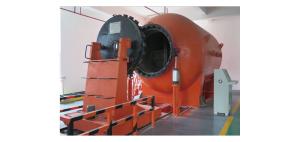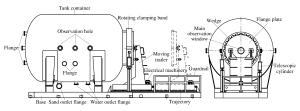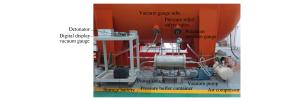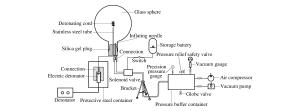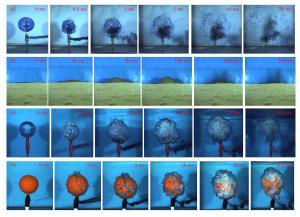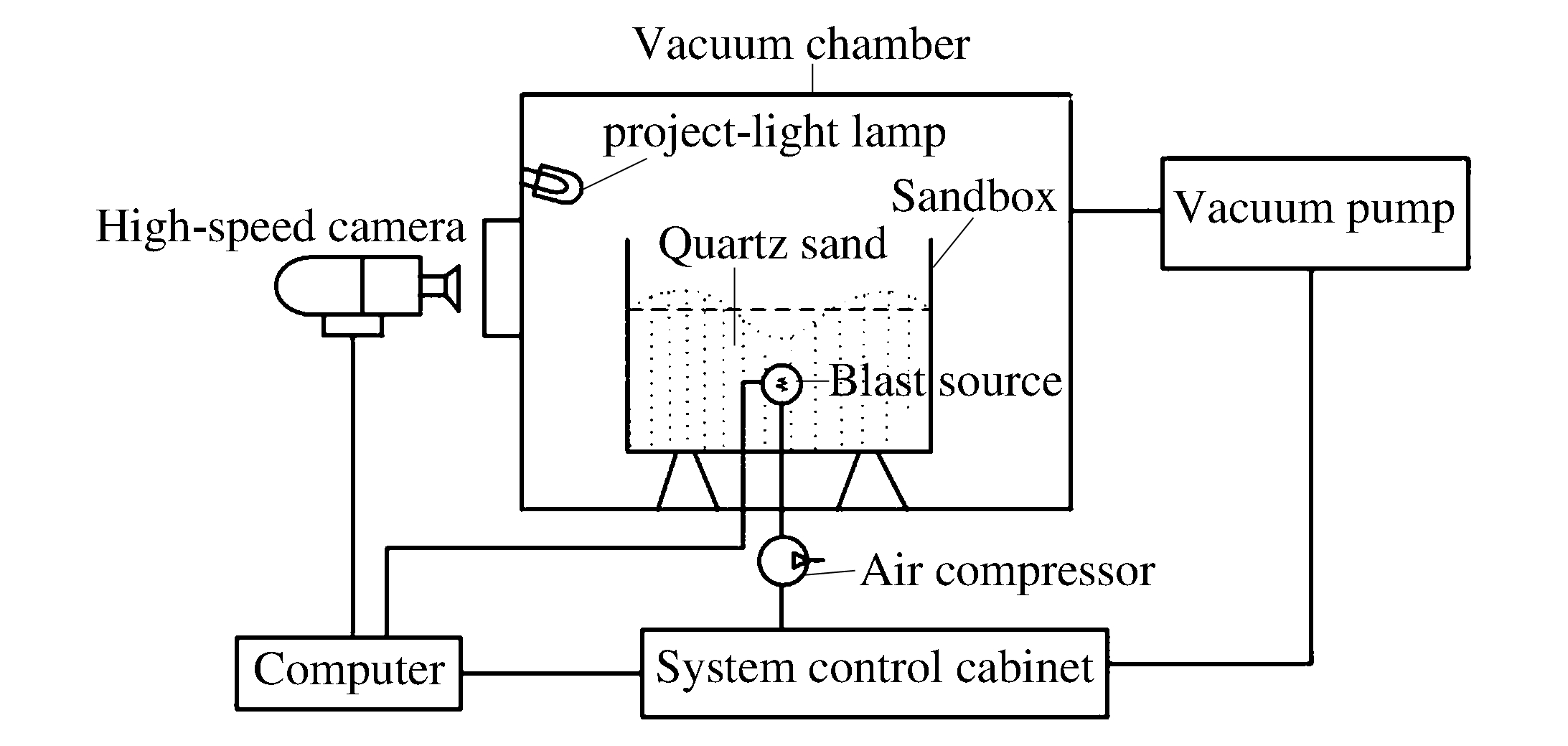Development of the testing apparatus for modeling large equivalent underground cratering explosions
-
摘要: 针对当前地下爆炸物理模型实验无法模拟大当量地下爆炸抛掷弹坑和疏松鼓包现象的难题,基于相似理论,采用地下爆炸效应真空室模型实验方法,研制了考虑重力影响的大当量地下爆炸效应模拟实验装置。整套装置由容器罐体、快开门密闭机构、爆源系统、真空泵组、量测控制系统等组成,提出的新型爆源模拟装置可以实现精确起爆控制。该装置可模拟0.1~100 kt TNT、埋深20~400 m范围内不同比尺的地下核爆炸成坑和隆起实验,同时也能够模拟不同装药配置方案、不同地质条件下的大当量地下浅埋化爆抛掷实验。典型的核爆抛掷成坑模型实验结果表明,装置实验参数精确可调,实验过程可控,实验结果可信,为钻地核武器地下爆炸毁伤效应分析和大型工程爆破效果预测预报提供了实验室模拟和科学研究设备,填补了爆炸离心机无法模拟大当量地下爆炸抛掷成坑效应的空白。Abstract: Aiming at solving the difficult problem of simulating the ejection crater and loose bulging under underground explosion, a method of vacuum chamber for simulating underground explosion effects is presented based on the similarity theory, and a testing apparatus is developed. The core assemblies of this apparatus consist of pressure vessel, fast-open door enclosed mechanism, explosive source simulation system with accurate burst control, vacuum pump air-removal system and instrumentation system. This set of apparatus could model the underground explosions with the equivalent of 0.1-100 kt TNT and the buried depth of 20-400 m, and it also could simulate the large-scale explosions with different charge schemes under complicated geological conditions. The typical modeling experimental results show that the apparatus is accurately adjusted and technically controllable, and that the experimental results are reliable. The testing apparatus for large-scale underground cratering explosions could provide assistances for both the damage effect analysis of the ejection explosions subject to earth-penetrating nuclear weapons and the prediction and forecast of the large-scale engineering blasting, and fill the shot of centrifuge cratering experiment which cannot model the large-scale underground explosions.
-
表 1 地下爆炸空腔气体势能计算表达式
Table 1. Formula for the energy of the gas potential energy of the cavity in underground explosion
岩石特性 空腔气体势能 不含气体岩石 $ A = 0.49q/\bar r_{\rm{n}}^{0.84} $ 仅含自由水的硅酸盐类岩石(适用于花岗岩、凝灰岩、冲积层等岩石) $ A = \frac{{0.49q}}{{\bar r_{\rm{n}}^{0.84}}}(1 + 5.8\eta _{\rm{w}}^{0.7}) $ 仅含碳酸气的碳酸盐类岩石(适用于硬石膏、方解石、石灰岩等岩石) $ A = \frac{{0.49q}}{{\bar r_{\rm{n}}^{0.84}}}(1 + 1.96\eta _{{\rm{C}}{{\rm{O}}_{\rm{2}}}}^{0.7}) $ 混合含气岩石 $ A = \frac{{0.49q}}{{{{\bar r}_{\rm{n}}}^{0.84}}}(1 + 5.8\eta _{\rm{m}}^{0.7}), \;\;\;{\eta _{\rm{m}}} = {\eta _w} + {\eta _{{\rm{C}}{{\rm{O}}_{\rm{2}}}{\rm{}}}}/4.7 $ 表 2 爆源球形度实验
Table 2. Sophericity experiments for the detonation device
实验编号 螺旋状柔爆索长度/cm 玻璃球罩中绝对气压/kPa 玻璃球罩埋深/cm 高速摄影拍摄帧数/s-1 玻璃球罩碎片平均直径/mm A1(空气) 20 100 5 000 5 A2(沙) 20 180 10 3 000 13 A3(水) 20 180 13 5 000 10 A4(水) 10 180 13 5 000 25 表 3 不同当量浅埋地下抛掷爆炸成坑效应模拟实验主要参数
Table 3. Key parameters for the simulation of large-scale underground cratering explosions
爆炸代号 原型参数 模型参数 等效TNT当量/kt 埋深/
m空腔半径/
m空腔气体能量/
GJ小球半径/
cm模拟比尺 小球埋深/
cm小球压力/
kPa真空度/
PaNeptun 0.115 30.5 7.29 62.31 5 146 21.0 135.219 686.0 1003竖井 1.100 48.0 13.32 452.76 5 266 18.0 87.036 375.4 Schooner 31.000 108.0 47.12 12 499.20 5 942 11.5 15.933 106.0 Sedan 100.000 193.0 69.62 48 720.00 5 1 392 13.9 12.825 71.8 表 4 模型实验结果
Table 4. Results of blasting crater
计算条件 弹坑半径/cm 弹坑深度/cm 体积/cm3 抛掷指数 原型试验 3 300.0 1 050.0 1.7×1010 1.0 相似计算结果 22.6 7.2 5 462 模型试验 25.6 6.3 4 321 1.2 相对误差/% 13.3 12.5 20.0 20.0 -
[1] 马立秋, 张建民, 张武.爆炸离心模型试验研究进展与展望[J].岩土力学, 2011, 32(9):2827-2833. doi: 10.3969/j.issn.1000-7598.2011.09.044MA Liqiu, ZHANG Jianmin, ZHANG Wu. Development and prospect for centrifugal blasting modeling[J]. Rock and Soil Mechanics, 2011, 32(9):2827-2833. doi: 10.3969/j.issn.1000-7598.2011.09.044 [2] 范一锴, 陈祖煜, 梁向前, 等.砂中爆炸成坑的离心模型试验分析方法比较[J].岩土力学与工程学报, 2011(suppl 2):4123-4128. http://www.wanfangdata.com.cn/details/detail.do?_type=perio&id=QK201104561938FAN Yikai, CHEN Zuyu, LIANG Xiangqian, et al. Comparison of three methods for geotechnical centrifuge model tests of explosion cratering in sand[J]. Chinese Journal of Rock Mechanics and Engineering, 2011(suppl 2):4123-4128. http://www.wanfangdata.com.cn/details/detail.do?_type=perio&id=QK201104561938 [3] 岳松林, 邱艳宇, 王德荣, 等.岩石中爆炸成坑效应的模型试验方法及对比分析[J].岩石力学与工程学报, 2014, 33(9):1925-1932. http://d.old.wanfangdata.com.cn/Periodical/yslxygcxb201409026YUE Songlin, QIU Yanyu, WANG Derong, et al. Modeling experiment methods for crating effects of explosions in rocks and comparative analysis[J]. Chinese Journal of Rock Mechanics and Engineering, 2014, 33(9):1925-1932. http://d.old.wanfangdata.com.cn/Periodical/yslxygcxb201409026 [4] SADOVSKⅡ M A, ADUSHKIN V V, RODIONOV V N, et al. A method of modeling large cratering explosions[J]. Combustion, Explosion, and Shock Waves, 1967, 3(1):73-79. doi: 10.1007/BF00741616 [5] ADUSHKIN V V, PERNIK L M. Large-scale blasting-down in opening-up the tyrnyauz deposit[J]. Journal of Mining Science, 1976, 12(4):381-384. doi: 10.1007/BF02497368 [6] ADUSHKIN V V, PERNIK L M. Characteristics of the formation of subsidence craters[J]. Fizika Goreniya I Vzryva, 1972, 8(4):541-552. doi: 10.1007/BF00741202 [7] Vakhrameev Y S. Physical principles of modeling excavation explosions[J]. Combustion, Explosion, and Shock Waves, 1995, 31(1):123-130. https://www.sciencedirect.com/science/article/pii/S1524070300905368 [8] Blinov I M, Vakhrameev Y S. Method of modeling of large excavation explosions by microexplosions of explosive[J]. Combustion, Explosion, and Shock Waves, 1995, 31(2):102-109. https://www.researchgate.net/publication/239381278_A_method_of_modeling_large_cratering_explosions [9] Blinov I M. Mechanism and conditions of hill formation at the crater bottom in an excavation explosion[J]. Combustion, Explosion, and Shock Waves, 2004, 40(6):679-685. http://www.wanfangdata.com.cn/details/detail.do?_type=perio&id=JJ022076828 [10] 谈庆明.量纲分析[M].合肥:中国科学技术大学出版社, 2005:9-18. [11] 钱七虎.大型抛掷爆破中重力的影响[J].解放军理工大学学报(自然科学版), 2010, 11(2):103-105. http://d.old.wanfangdata.com.cn/Periodical/jfjlgdxxb201002001QIAN Qihu. Influence of gravity in large-scale throw blasting[J]. Journal of PLA University of Science and Technology (Natural Science), 2010, 11(2):103-105. http://d.old.wanfangdata.com.cn/Periodical/jfjlgdxxb201002001 [12] CHIKOSHA S, MAHLATJI L M, CHIKWANDA H K. Characterisation of titanium powder flow, shear and bulk properties using the FT4 powder rheometer[J]. Advanced Materials Research, 2014, 1019:218-224. https://www.scientific.net/AMR.1019.218 [13] ADUSHKIN V V, SPIVAK A. Underground explosions: WGC-2015-03[R]. 2015. -







 下载:
下载:
